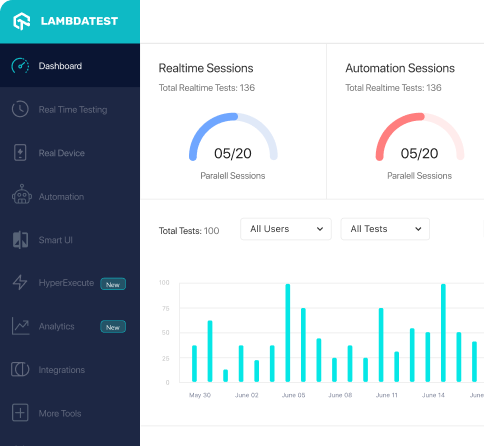How to use PerformanceTimingMetricsFactory class of org.fluentlenium.core.performance package
Best FluentLenium code snippet using org.fluentlenium.core.performance.PerformanceTimingMetricsFactory
Source:DefaultPerformanceTiming.java
...24public class DefaultPerformanceTiming implements PerformanceTiming {25 private static final String PERFORMANCE_TIMING_SCRIPT = "return window.performance.timing;";26 private static final String PERFORMANCE_TIMING_EVENTS_SCRIPT = "return window.performance.timing.%s;";27 private final WebDriver driver;28 private final PerformanceTimingMetricsFactory metricsFactory = new PerformanceTimingMetricsFactory();29 public DefaultPerformanceTiming(WebDriver driver) {30 this.driver = driver;31 }32 @Override33 public long getEventValue(PerformanceTimingEvent event) {34 checkArgument(event, "The event should not be null.");35 return timePassedUntil(execute(scriptFor(event)));36 }37 @Override38 public Object secureConnectionStart() {39 Object secureConnectionStart = execute(scriptFor(SECURE_CONNECTION_START));40 if (secureConnectionStart instanceof Long) {41 secureConnectionStart = timePassedUntil(secureConnectionStart);42 }...Source:PerformanceTimingMetricsFactoryTest.java
...6import java.util.Map;7import static org.assertj.core.api.Assertions.assertThat;8import static org.assertj.core.api.Assertions.assertThatExceptionOfType;9/**10 * Unit test for {@link PerformanceTimingMetricsFactory}.11 */12public class PerformanceTimingMetricsFactoryTest {13 private final PerformanceTimingMetricsFactory factory = new PerformanceTimingMetricsFactory();14 @Test15 public void shouldCreateDefaultMetricsFactory() {16 Map<String, Object> timingObject = new HashMap<>();17 timingObject.put(PerformanceTimingEvent.SECURE_CONNECTION_START.getEvent(), 150000L);18 timingObject.put(PerformanceTimingEvent.NAVIGATION_START.getEvent(), 27500L);19 assertThat(factory.createFor(timingObject)).isInstanceOf(DefaultPerformanceTimingMetrics.class);20 }21 @Test22 public void shouldCreateHtmlUnitMetricsFactory() {23 PerformanceTiming htmlUnitPerformanceTiming = new PerformanceTiming();24 assertThat(factory.createFor(htmlUnitPerformanceTiming)).isInstanceOf(HtmlUnitPerformanceTimingMetrics.class);25 }26 @Test27 public void shouldThrowExceptionForUnknownImplementation() {...Source:UnknownPerformanceTimingImplementationException.java
1package org.fluentlenium.core.performance;2/**3 * Exception for when the browser specific PerformanceTiming API implementation is not (yet) supported by FluentLenium.4 *5 * @see PerformanceTimingMetricsFactory6 */7class UnknownPerformanceTimingImplementationException extends RuntimeException {8 UnknownPerformanceTimingImplementationException(String message) {9 super(message);10 }11}...PerformanceTimingMetricsFactory
Using AI Code Generation
1import org.fluentlenium.core.performance.PerformanceTimingMetricsFactory;2import org.fluentlenium.core.performance.PerformanceTimingMetrics;3import org.fluentlenium.core.performance.PerformanceTiming;4import org.fluentlenium.core.performance.PerformanceTimingMetricsFactory;5import org.fluentlenium.core.performance.PerformanceTimingMetrics;6import org.fluentlenium.core.performance.PerformanceTiming;7import static org.assertj.core.api.Assertions.assertThat;8import static org.assertj.core.api.Assertions.assertThat;9import java.util.Arrays;10import java.util.List;11import java.util.Map;12import java.util.stream.Collectors;13import java.util.stream.Collectors;14import java.util.stream.Stream;15import java.util.stream.Stream;16import java.util.stream.Stream;17import java.util.Map;PerformanceTimingMetricsFactory
Using AI Code Generation
1package com.javatpoint;2import org.fluentlenium.adapter.junit.FluentTest;3import org.fluentlenium.core.performance.PerformanceTimingMetrics;4import org.fluentlenium.core.performance.PerformanceTimingMetricsFactory;5import org.junit.Test;6import org.openqa.selenium.WebDriver;7import org.openqa.selenium.htmlunit.HtmlUnitDriver;8public class TestPerformanceTimingMetricsFactory extends FluentTest{9 public WebDriver getDefaultDriver() {10 return new HtmlUnitDriver();11 }12 public void testPerformanceTimingMetricsFactory() {13 PerformanceTimingMetricsFactory performanceTimingMetricsFactory = new PerformanceTimingMetricsFactory();14 PerformanceTimingMetrics performanceTimingMetrics = performanceTimingMetricsFactory.create(getDefaultDriver(), url);15 System.out.println("Performance Timing Metrics: "+performanceTimingMetrics);16 }17}18Performance Timing Metrics: PerformanceTimingMetrics{connectTime=0, dnsTime=0, domCompleteTime=0, domContentLoadedEventEnd=0, domContentLoadedEventStart=0, domInteractiveTime=0, domLoadingTime=0, domainLookupTime=0, fetchStart=0, loadEventEnd=0, loadEventStart=0, navigationStartTime=0, redirectTime=0, requestTime=0, responseTime=0, secureConnectionTime=0, unloadEventEnd=0, unloadEventStart=0}PerformanceTimingMetricsFactory
Using AI Code Generation
1package com.example;2import org.fluentlenium.adapter.FluentTest;3import org.fluentlenium.core.performance.PerformanceTimingMetrics;4import org.fluentlenium.core.performance.PerformanceTimingMetricsFactory;5import org.junit.Test;6import org.openqa.selenium.WebDriver;7public class PerformanceTimingMetricsFactoryTest extends FluentTest {8 public WebDriver getDefaultDriver() {9 return null;10 }11 public void test() {12 PerformanceTimingMetricsFactory performanceTimingMetricsFactory = new PerformanceTimingMetricsFactory();13 PerformanceTimingMetrics performanceTimingMetrics = performanceTimingMetricsFactory.create();14 }15}16package com.example;17import org.fluentlenium.adapter.FluentTest;18import org.fluentlenium.core.performance.PerformanceTimingMetrics;19import org.fluentlenium.core.performance.PerformanceTimingMetricsFactory;20import org.junit.Test;21import org.openqa.selenium.WebDriver;22public class PerformanceTimingMetricsFactoryTest extends FluentTest {23 public WebDriver getDefaultDriver() {24 return null;25 }26 public void test() {27 PerformanceTimingMetricsFactory performanceTimingMetricsFactory = new PerformanceTimingMetricsFactory();28 PerformanceTimingMetrics performanceTimingMetrics = performanceTimingMetricsFactory.create();29 }30}31package com.example;32import org.fluentlenium.adapter.FluentTest;33import org.fluentlenium.core.performance.PerformanceTimingMetrics;34import org.fluentlenium.core.performance.PerformanceTimingMetricsFactory;35import org.junit.Test;36import org.openqa.selenium.WebDriver;37public class PerformanceTimingMetricsFactoryTest extends FluentTest {38 public WebDriver getDefaultDriver() {39 return null;40 }41 public void test() {42 PerformanceTimingMetricsFactory performanceTimingMetricsFactory = new PerformanceTimingMetricsFactory();43 PerformanceTimingMetrics performanceTimingMetrics = performanceTimingMetricsFactory.create();44 }45}46package com.example;47import org.fluentlenium.adapter.FluentTest;48import org.fluentlenium.core.performance.PerformanceTimingMetricsPerformanceTimingMetricsFactory
Using AI Code Generation
1import org.fluentlenium.core.FluentDriver;2import org.fluentlenium.core.performance.PerformanceTimingMetricsFactory;3import org.openqa.selenium.WebDriver;4import java.util.Map;5public class 4 extends FluentDriver {6 public 4(WebDriver webDriver) {7 super(webDriver);8 }9 public static void main(String[] args) {10 FluentDriver fluentDriver = new 4(new ChromeDriver());11 Map<String, Long> metrics = PerformanceTimingMetricsFactory.getMetrics(fluentDriver.getDriver());12 System.out.println("Page load time: " + metrics.get("pageLoadTime"));13 System.out.println("Redirect time: " + metrics.get("redirectTime"));14 System.out.println("DNS lookup time: " + metrics.get("dnsLookupTime"));15 System.out.println("Time to first byte: " + metrics.get("timeToFirstByte"));16 System.out.println("Content download time: " + metrics.get("contentDownloadTime"));17 }18}PerformanceTimingMetricsFactory
Using AI Code Generation
1package com.example;2import org.fluentlenium.adapter.junit.FluentTest;3import org.junit.Test;4import org.openqa.selenium.WebDriver;5import org.openqa.selenium.chrome.ChromeDriver;6public class PerformanceMetrics extends FluentTest {7 public WebDriver newWebDriver() {8 return new ChromeDriver();9 }10 public void test() {11 PerformanceTimingMetricsFactory performanceTimingMetricsFactory = new PerformanceTimingMetricsFactory(getDriver());12 System.out.println("First paint: " + performanceTimingMetricsFactory.getNavigationTimingMetrics().getFirstPaint());13 System.out.println("First contentful paint: " + performanceTimingMetricsFactory.getNavigationTimingMetrics().getFirstContentfulPaint());14 System.out.println("First meaningful paint: " + performanceTimingMetricsFactory.getNavigationTimingMetrics().getFirstMeaningfulPaint());15 System.out.println("First input delay: " + performanceTimingMetricsFactory.getNavigationTimingMetrics().getFirstInputDelay());16 System.out.println("First CPU idle: " + performanceTimingMetricsFactory.getNavigationTimingMetrics().getFirstCPUIdle());17 System.out.println("First interactive: " + performanceTimingMetricsFactory.getNavigationTimingMetrics().getFirstInteractive());18 System.out.println("Time to interactive: " + performanceTimingMetricsFactory.getNavigationTimingMetrics().getTimeToInteractive());19 System.out.println("Speed index: " + performanceTimingMetricsFactory.getNavigationTimingMetrics().getSpeedIndex());20 System.out.println("Estimated input latency: " + performanceTimingMetricsFactory.getNavigationTimingMetrics().getEstimatedInputLatency());21 }22}23package com.example;24import org.fluentlenium.adapter.junit.FluentTest;25import org.junit.Test;26import org.openqa.selenium.WebDriver;27import org.openqa.selenium.chrome.ChromeDriver;28public class PerformanceMetrics extends FluentTest {29 public WebDriver newWebDriver() {30 return new ChromeDriver();31 }32 public void test() {33 PerformanceTimingMetricsFactory performanceTimingMetricsFactory = new PerformanceTimingMetricsFactory(getDriver());34 System.out.println("First paint: " + performanceTimingMetricsFactory.getNavigationTimingMetrics().getFirstPaint());35 System.out.println("Automation Testing Tutorials
Learn to execute automation testing from scratch with LambdaTest Learning Hub. Right from setting up the prerequisites to run your first automation test, to following best practices and diving deeper into advanced test scenarios. LambdaTest Learning Hubs compile a list of step-by-step guides to help you be proficient with different test automation frameworks i.e. Selenium, Cypress, TestNG etc.
LambdaTest Learning Hubs:
- JUnit Tutorial
- TestNG Tutorial
- Webdriver Tutorial
- WebDriverIO Tutorial
- Protractor Tutorial
- Selenium 4 Tutorial
- Jenkins Tutorial
- NUnit Tutorial
- Jest Tutorial
- Playwright Tutorial
- Cypress Tutorial
- PyTest Tutorial
YouTube
You could also refer to video tutorials over LambdaTest YouTube channel to get step by step demonstration from industry experts.
Most used methods in PerformanceTimingMetricsFactory
Try LambdaTest Now !!
Get 100 minutes of automation test minutes FREE!!



